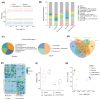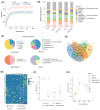Microbial Biogeography along the Gastrointestinal Tract of a Wild Chinese Muntjac (Muntiacus reevesi)
- PMID: 39203429
- PMCID: PMC11356339
- DOI: 10.3390/microorganisms12081587
Microbial Biogeography along the Gastrointestinal Tract of a Wild Chinese Muntjac (Muntiacus reevesi)
Abstract
The gut microbiota plays an important role in host nutrient absorption, immune function, and behavioral patterns. Much research on the gut microbiota of wildlife has focused on feces samples, so the microbial composition along the gastrointestinal tract of wildlife is not well reported. To address this gap, we performed high-throughput sequencing of 16s rRNA genes and ITs rRNA genes in the gastrointestinal contents of a wild adult male Chinese muntjac (Muntiacus reevesi) to comparatively analyze the microbial diversity of different gastrointestinal regions. The results showed that the dominant bacterial phyla were Firmicutes (66.19%) and Bacteroidetes (22.7%), while the dominant fungal phyla were Ascomycetes (72.81%). The highest bacterial diversity was found in the stomach, and the highest fungal diversity was found in the cecum. The microbial communities of the large intestine and small intestine were of similar structures, which were distinct from that of the stomach. These results would facilitate the continued exploration of the microbial composition and functional diversity of the gastrointestinal tract of wild Chinese muntjacs and provide a scientific basis for microbial resource conservation of more wildlife.
Keywords: Chinese muntjac; gastrointestinal tract; gut microbiota.
Conflict of interest statement
The authors declare no conflicts of interest.
Figures



Similar articles
-
Gastrointestinal Biogeography of Luminal Microbiota and Short-Chain Fatty Acids in Sika Deer (Cervus nippon).Appl Environ Microbiol. 2022 Sep 13;88(17):e0049922. doi: 10.1128/aem.00499-22. Epub 2022 Aug 11. Appl Environ Microbiol. 2022. PMID: 35950850 Free PMC article.
-
Establishment and characterization of a fibroblast cell line from postmortem skin of an adult Chinese muntjac (Muntiacus reevesi).In Vitro Cell Dev Biol Anim. 2020 Feb;56(2):97-102. doi: 10.1007/s11626-019-00422-8. Epub 2020 Jan 2. In Vitro Cell Dev Biol Anim. 2020. PMID: 31898011
-
Genetic hypogonadal mouse model reveals niche-specific influence of reproductive axis and sex on intestinal microbial communities.Biol Sex Differ. 2023 Nov 6;14(1):79. doi: 10.1186/s13293-023-00564-1. Biol Sex Differ. 2023. PMID: 37932822 Free PMC article.
-
Microbial Biogeography Along the Gastrointestinal Tract of a Red Panda.Front Microbiol. 2018 Jul 5;9:1411. doi: 10.3389/fmicb.2018.01411. eCollection 2018. Front Microbiol. 2018. PMID: 30026734 Free PMC article.
-
Characterization of the microbial communities along the gastrointestinal tract of sheep by 454 pyrosequencing analysis.Asian-Australas J Anim Sci. 2017 Jan;30(1):100-110. doi: 10.5713/ajas.16.0166. Epub 2016 Jun 30. Asian-Australas J Anim Sci. 2017. PMID: 27383798 Free PMC article.
Cited by
-
Comparative analysis of the gut microbiota composition and diversity in Erinaceus amurensis from the Wandashan Mountain range area based on metagenomics.Front Microbiol. 2024 Dec 5;15:1479352. doi: 10.3389/fmicb.2024.1479352. eCollection 2024. Front Microbiol. 2024. PMID: 39703701 Free PMC article.
-
Human Digestive Physiology and Evolutionary Diet: A Metabolomic Perspective on Carnivorous and Scavenger Adaptations.Metabolites. 2025 Jul 4;15(7):453. doi: 10.3390/metabo15070453. Metabolites. 2025. PMID: 40710552 Free PMC article. Review.
References
Grants and funding
LinkOut - more resources
Full Text Sources
Miscellaneous

